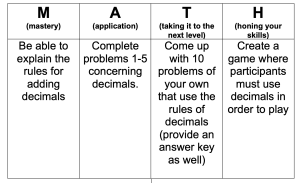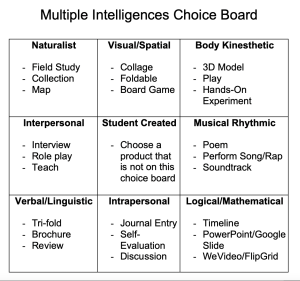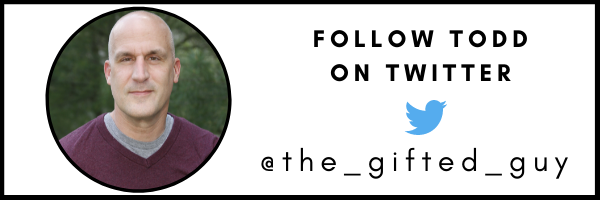TL;DR:
- When you differentiate, what are you doing for students who need more of a challenge?
- You must differentiate up as well.
When we hear the term differentiate, we often think this means differentiating to support kids who are struggling. It might mean taking a complex task and chunking it into more easy-to-digest pieces. It could be scaffolding a lesson so that students can start with something more accessible to them and then work their way up. Maybe it takes the form of an assessment that allows a student to give their answers verbally since they are weak at writing. But differentiation is a two-way street. It goes up as well.
When you have a student who has a high ability, what are you doing to meet their needs? How are you going to change your questions, your activities, or your assessments to challenge these students? How exactly do you differentiate up?
Remember that differentiation can be done in various places in the lesson whether it be the content, the process, or the product. Share on XWhat does it mean to differentiate up?
Imagine a student who can multiply multi-digit numbers together with ease whilst in a third-grade class learning the basics of how to multiply two, single-digit numbers. Think of a 9th-grade girl who reads the works of Flaubert and Chaucer being asked to read a James Patterson book with the rest of her class. These students are already ahead of their grade mates and yet often are asked to wait and let the rest catch up. What about their progress as a learner? Don’t we want them to be moving forward and not stuck in a holding pattern? Shouldn’t we be pushing these students to the limits of their abilities?
We have to differentiate up for these students. What exactly does that mean? It means introducing the math student who can multiply multi-digit numbers to new concepts such as division and algebraic thinking. It means helping the 9th grade girl choose a different book that will challenge her high reading ability. This would be meeting the student where they are at. This would be differentiating up.
Furthermore, remember that differentiation can be done in various places in the lesson whether it be the content, the process, or the product.
Content
In American schools, teachers are responsible for content standards written for each grade level that is determined by the state. This means that students are learning the same thing and thus they should be moving at the same pace. We know this not to be the case with many students. Some fall behind while others are way ahead. And yet we proceed with moving everyone along together.
Differentiating the content up means you are taking the content standards and adding another complex layer to them. For example, a 4th grade ELA CCSS standard is:
- Determine a theme of a story, drama, or poem from details in the text; summarize the text.
You could add another layer by asking a student to analyze (higher level of Bloom’s) the text as well. They could determine whether this theme was written in an effective way or if it could have been achieved in a different manner.
It could mean introducing a student to an above-grade-level standard. Here is a CCSS 7th grade made standard:
- Solve real-world and mathematical problems involving the four operations with rational numbers.
The teacher could ask a student who has mastered this to try the high school standard that extends the same concept:
- Explain why the sum or product of two rational numbers is rational; that the sum of a rational number and an irrational number is irrational; and that the product of a nonzero rational number and an irrational number is irrational.
Or it could involve making the content more real-world by having students learn about the standard in an authentic way. Take this Next Generation Science Standard for example:
- Analyze a major global challenge to specify qualitative and quantitative criteria and constraints for solutions that account for societal needs and wants.
You could make this more relevant by having them develop a product of their own designed to solve said problem and present it to a group of judges in a competition such as the Conrad Challenge.
Process
This is how a student learns. Do they all need to read a textbook to gather information or do they have to use the same method of learning? Essentially do all students need to be doing the same activities as one another? Could students develop the processes that work best for them and use these to learn?
What this might look like if you are differentiating up is rather than giving a student a resource, having them find the research independently on their own. Allow a student to watch a video they have found that goes into more depth rather than reading an article with the basics. Give students the opportunity to work at their own pace rather than staying with the class, digging deeper with the spare time they have. Rather than the teacher teaching the class, allowing the student to do this. Project-based learning and other authentic methods such as problem- and case-based are other ways to differentiate the process.
Product
What are students producing in order to show you what they have learned? In a traditional classroom, students are all taking the same assessment. What if you gave students different assessments based on their abilities? This way you are assessing the student’s level of understanding rather than a standard one.
An easy way to differentiate up for product would be to provide students with choice. It may be a limited choice such as giving students this choice board with four options:

This allows students to enter into whatever level they feel comfortable taking on, starting with the basics and moving up in the levels of thinking. You might provide choices based on the multiple intelligences such as this choice board:

It could be giving students complete choice in showing you how they have mastered the lesson. This allows them to explore new learning/skills they have wanted to try or to strengthen ones they are already good at. A student who is artistic can choose a product that allows him to display this talent. A student who is tech savvy might design a website sharing what she learned.
[scroll down to keep reading]The 4th Option for Differentiation
A fourth way you can differentiate up is through the environment. This might be putting students who are identified as gifted in a subject area together in order to better meet their needs. My next post will discuss how even by doing this, there needs to be differentiation taking place.
Putting the “Different” in Differentiation
There is a reason why the word different is in differentiation. Any student, whichever end of the spectrum or smack dab in the middle, has specific needs. Our goal as teachers are to meet these needs as best we can. If you are going to meet the needs of students who are high ability or gifted, you are going to have to figure out a way to differentiate up. You are going to have to do something different.
About Todd Stanley
Todd Stanley is a National Board teacher and the author of many teacher-education books including Project-Based Learning for Gifted Students: A Handbook for the 21st Century Classroom (2nd Edition), Authentic Learning: Real World Experiences that Build 21st Century Skills, and his most recent How the Hell Do We Motivate These Kids? He served as a classroom teacher for 18 years where he worked with parents to create two gifted programs for Reynoldsburg Schools as well as serving as their gifted coordinator for two years. He is currently the gifted services coordinator for Pickerington Local Schools where he lives with his wife and two daughters. You can follow him on Twitter @the_gifted_guy or visit his website at thegiftedguy.com where you can access blogs, resources, and view presentations he has given.



